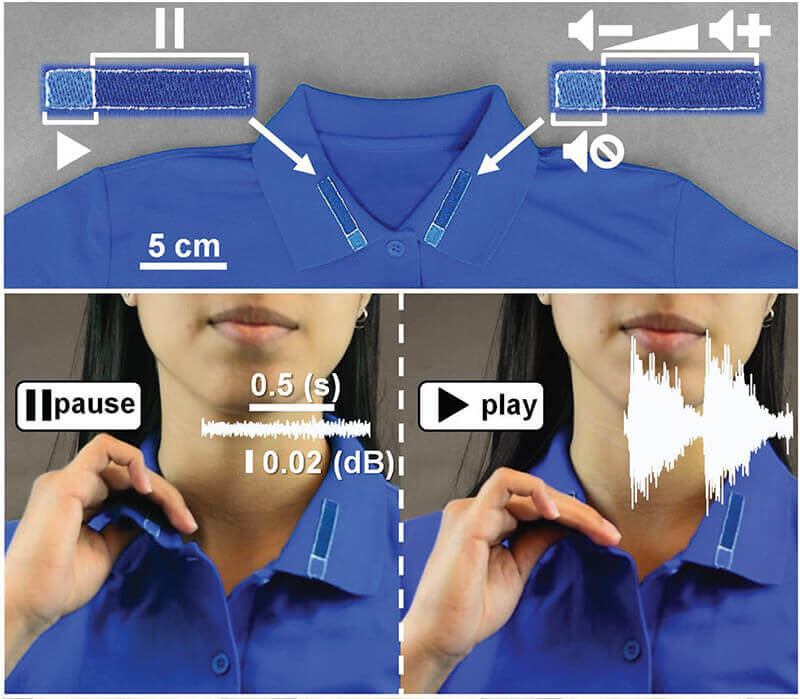August 8, 2019
This designer clothing lets users turn on electronics while turning away bacteria
New rainproof, stainproof technology turns clothing into self-powered remotes
 Purdue University researchers have developed a new fabric innovation that allows the wearer to control electronic devices through the clothing. (Image provided)
Download image
Purdue University researchers have developed a new fabric innovation that allows the wearer to control electronic devices through the clothing. (Image provided)
Download image
WEST LAFAYETTE, Ind. – A new addition to your wardrobe may soon help you turn on the lights and music – while also keeping you fresh, dry, fashionable, clean and safe from the latest virus that’s going around.
Purdue University researchers have developed a new fabric innovation that allows wearers to control electronic devices through clothing.
“It is the first time there is a technique capable to transform any existing cloth item or textile into a self-powered e-textile containing sensors, music players or simple illumination displays using simple embroidery without the need for expensive fabrication processes requiring complex steps or expensive equipment,” said Ramses Martinez, an assistant professor in the School of Industrial Engineering and in the Weldon School of Biomedical Engineering in Purdue’s College of Engineering.
The technology is featured in the July 25 edition of Advanced Functional Materials.
“For the first time, it is possible to fabricate textiles that can protect you from rain, stains, and bacteria while they harvest the energy of the user to power textile-based electronics,” Martinez said. “These self-powered e-textiles also constitute an important advancement in the development of wearable machine-human interfaces, which now can be washed many times in a conventional washing machine without apparent degradation.”
 Purdue waterproof, breathable and antibacterial self-powered clothing is based on omniphobic triboelectric nanogenerators. (Image provided)
Download image
Purdue waterproof, breathable and antibacterial self-powered clothing is based on omniphobic triboelectric nanogenerators. (Image provided)
Download image
Martinez said the Purdue waterproof, breathable and antibacterial self-powered clothing is based on omniphobic triboelectric nanogenerators (RF-TENGs) – which use simple embroidery and fluorinated molecules to embed small electronic components and turn a piece of clothing into a mechanism for powering devices. The Purdue team says the RF-TENG technology is like having a wearable remote control that also keeps odors, rain, stains and bacteria away from the user.
“While fashion has evolved significantly during the last centuries and has easily adopted recently developed high-performance materials, there are very few examples of clothes on the market that interact with the user,” Martinez said. “Having an interface with a machine that we are constantly wearing sounds like the most convenient approach for a seamless communication with machines and the Internet of Things.”
The technology is being patented through the Purdue Research Foundation Office of Technology Commercialization. The researchers are looking for partners to test and commercialize their technology.
Their work aligns with Purdue's Giant Leaps celebration of the university’s global advancements in artificial intelligence and health as part of Purdue’s 150th anniversary. It is one of the four themes of the yearlong celebration’s Ideas Festival, designed to showcase Purdue as an intellectual center solving real-world issues.
About Purdue Research Foundation Office of Technology Commercialization
The Purdue Research Foundation Office of Technology Commercialization operates one of the most comprehensive technology transfer programs among leading research universities in the U.S. Services provided by this office support the economic development initiatives of Purdue University and benefit the university's academic activities through commercializing, licensing and protecting Purdue intellectual property. The office is managed by the Purdue Research Foundation, which received the 2016 Innovation and Economic Prosperity Universities Award for Innovation from the Association of Public and Land-grant Universities. For more information on licensing a Purdue innovation, contact the Office of Technology Commercialization at otcip@prf.org. For more information about funding and investment opportunities in startups based on a Purdue innovation, contact the Purdue Foundry at foundry@prf.org.The Purdue Research Foundation is a private, nonprofit foundation created to advance the mission of Purdue University.
Writer: Chris Adam, 765-588-3341, cladam@prf.org
Source: Ramses Martinez, rmartinez@purdue.edu
Abstract
Waterproof, Breathable, and Antibacterial Self‐Powered e‐Textiles Based on Omniphobic Triboelectric Nanogenerators
Marina Sala de Medeiros, Daniela Chanci, Carolina Moreno, Debkalpa Goswami and Ramses V. Martinez
Multifunctional electronic textiles (e‐textiles) incorporating miniaturized electronic devices will pave the way toward a new generation of wearable devices and human–machine interfaces. Unfortunately, the development of e‐textiles is subject to critical challenges, such as battery dependence, breathability, satisfactory washability, and compatibility with mass production techniques. This work describes a simple and cost‐effective method to transform conventional garments and textiles into waterproof, breathable, and antibacterial e‐textiles for self‐powered human–machine interfacing. Combining embroidery with the spray‐based deposition of fluoroalkylated organosilanes and highly networked nanoflakes, omniphobic triboelectric nanogenerators (RF‐TENGs) can be incorporated into any fiber‐based textile to power wearable devices using energy harvested from human motion. RF‐TENGs are thin, flexible, breathable (air permeability 90.5 mm s−1), inexpensive to fabricate (<0.04$ cm−2), and capable of producing a high power density (600 µW cm−2). E‐textiles based on RF‐TENGs repel water, stains, and bacterial growth, and show excellent stability under mechanical deformations and remarkable washing durability under standard machine‐washing tests. Moreover, e‐textiles based on RF‐TENGs are compatible with large‐scale production processes and exhibit high sensitivity to touch, enabling the cost‐effective manufacturing of wearable human–machine interfaces.

